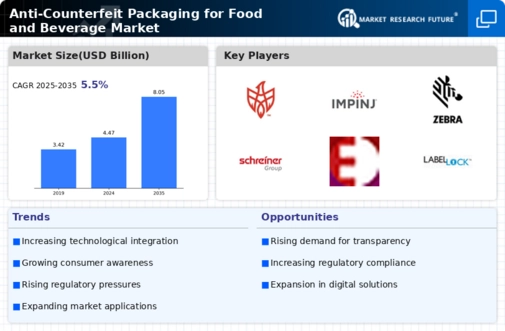The Anti-Counterfeit Packaging for Food and Beverage Market has become a critical segment in the packaging industry, driven by rising concerns regarding product safety, food authenticity, and consumer confidence. The prevalence of counterfeit products has compelled manufacturers to adopt advanced anti-counterfeit technologies to secure their brand integrity and ensure consumer protection. The market encompasses various packaging solutions that incorporate innovative features like holograms, QR codes, and RFID technologies to detect and prevent tampering.
Competitive insights into this market reveal that companies are not only focusing on technology advancements but also emphasizing sustainability and regulatory compliance to build trust with consumers and stakeholders alike. As the market continues to evolve, staying ahead of the competition requires a robust understanding of market trends, consumer behavior, and the dynamics of the supply chain.Phoenix Packaging has established a strong presence in the Anti-Counterfeit Packaging for Food and Beverage Market by leveraging its advanced packaging solutions. The company is recognized for its innovative approach to protecting products through intelligent packaging technologies.
With a focus on quality and reliability, Phoenix Packaging offers comprehensive anti-counterfeit measures that enhance product safety and foster consumer trust. The company's strengths lie in its ability to integrate cutting-edge technologies into its packaging processes, enabling manufacturers to monitor and authenticate their products effectively. By positioning itself as a trusted partner for food and beverage manufacturers, Phoenix Packaging plays a pivotal role in addressing the growing demand for secure packaging solutions amid rising concerns about counterfeiting.Impinj has carved a niche in the Anti-Counterfeit Packaging for Food and Beverage Market with its specialized offerings tailored to enhance product authenticity.
The company is synonymous with innovation, particularly in the field of radio-frequency identification (RFID) technology. Impinj's solutions enable real-time tracking and verification of products throughout the supply chain, significantly reducing the risks associated with counterfeiting. By providing brands with the tools necessary to authenticate their products, Impinj enhances consumer confidence and helps manufacturers protect their brand equity. The company's commitment to research and development allows it to remain at the forefront of technology advancements, ensuring that its clients have access to the most effective anti-counterfeit measures available in the market.
With a robust reputation for quality and a focus on customer-centric solutions, Impinj continues to impact the Anti-Counterfeit Packaging for Food and Beverage Market effectively.




















Leave a Comment